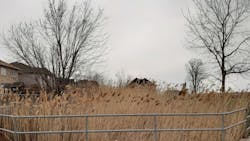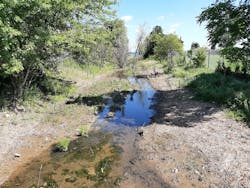The City of Hamilton, Ontario is intersected by the Niagara Escarpment, producing hundreds of kilometers of natural watercourses. Hamilton Water manages roughly 148 kilometers (about 91.5 miles) of these watercourses, which flow into Lake Ontario and Lake Erie.
To mitigate the impacts of development on natural watercourses, the city has approximately 130 stormwater management facilities (SWMFs) that detain runoff and release water at a pace designed to mimic the undisturbed natural forested landscape. SWMFs in the City of Hamilton include wet ponds, wetlands, dry ponds, and low impact development (LID) end-of-pipe systems.
These facilities, installed in newly developed subdivisions, help protect watercourses by reducing flooding and erosion. They also improve water quality by allowing sediment and pollutants to settle at the bottom of the pond before flowing into creeks. Limiting obstruction of these facilities is paramount to maintaining safe water management for both people and the environment.
In 2020, Hamilton Water documented that approximately 60 of its SWMF were being infested by a highly invasive perennial grass, known as Phragmites, European common reed, or Phragmites australis. Phragmites can grow to 5 meters (16 feet) tall and can have very dense stands of 200 stems per square meter (18.5 stems per square foot). All this growth can clog inlet and outlet drainage channels and outcompete the more favorable native plant species that were planted in the facility. Sediment also gets trapped in these stands, which then reduces the water capacity of the pond, increasing the potential for flooding during a rainstorm.
“Stormwater ponds can provide ideal conditions for this invasive species, as Phragmites is often the first species to colonize exposed soils, preferring disturbed lands and being very opportunistic in their spread,” says Don Young, water distribution and wastewater collection superintendent for Hamilton Water.
The City of Hamilton is not alone in dealing with the invasion of Phragmites; it is a province-wide problem that the Ontario government is working hard to address.
Spreading 'Like Wildfire'
Originally from Eurasia, Phragmites were brought to North America to be sold as ornamental grasses. They spread voraciously with several modes of reproduction — including the dispersal of seeds, through rhizomes in the roots, and through fragments of roots that break off the plant. The plant produces thousands of seeds annually that can be transported by wind, flow down waterways, attach to animals, or even get stuck onto vehicles or machinery that then spread it to other locations. The plant’s roots and rhizomes actively secrete toxins into the soil, impeding or even killing the growth of neighboring plant species.
Phragmites rhizomes can grow several meters horizontally every year, and any fragments of the stolons (or ground runners) can produce new plants, meaning that cutting the plant down does not stop it from growing, and may even encourage new growth. Stolons are so hardy that studies have shown that, after a prescribed burn with fire, the rhizomes still spread — sometimes much faster. The most effective solution to rid Hamilton’s SWMFs of this invasive species is through herbicide spraying.
A Four-Year Eradication Program
In August 2020, the city treated 53 SWMFs by rolling and spraying with the herbicide WeatherMax (glyphosate). The practice of rolling effectively flattens the plant before spraying to increase the effectiveness of the herbicide application. This also allowed Hamilton Water to clearly see the extent of the infestation.
The herbicide used is the first choice of the Ontario Invasive Plant Council (OIPC) and the Ministry of Natural Resources and Forestry (MNRF) for use in sensitive natural environments. However, glyphosate is not able to be used on plants that are over water. This meant that the water needed to be pumped out before the herbicide application, which was costly and time consuming. After waiting approximately 35 days after spraying, allowing the herbicide to work and reach the roots, the dead Phragmites’ stands were removed.
“The 2020 treatment was effective, as re-growth in the following year was significantly reduced in most of the locations,” says Young. “We estimate that, in some stands, we achieved 100 percent eradication and averaged higher than 50 percent die-off overall.”
Evolving Best Practices to Accelerate Eradication
In 2021, Hamilton made several changes to its best practices, which enhanced its ability to remove the invasive species.
“The new approach maintains best management practices and significantly reduces the cost of Phragmites management,” says Young. “Density and height were considerably reduced after the new treatment practices in 2021.”
First, the city eliminated rolling after a review of a newly issued best management practice document put out by the OIPC in 2020. The document indicated that rolling and breaking the stalks was not beneficial. Rolling breaks the live plant’s stems, which prevents the intact stalk’s photosynthetic flow paths from carrying the pesticide’s active ingredients from the tops of the plants into the roots. While the flattened Phragmites’ stalks would be killed by pesticide, their roots could survive unharmed.
Rolling could also easily break off dying and brittle stalks from the stands. If heavy rainfall were to during the days between spraying and removal, this debris could wash downstream and clog drains.
In 2021, a new herbicide, HabitatAqua, was approved in Canada for use over water — which meant that pumping out the water prior to spraying was no longer necessary. No longer pumping out the water brought more than savings to cost and time: the city was also able to streamline the removal process by not removing stands that were less dense and, more importantly, not causing an issue of displacing permanent pool volume for flood mitigation.
“We have tracked all our spraying with ArcGIS Field Maps and have mapped each stand with density and height estimates; this enables us to assess the results of our treatment practices with real quantitative data every year,” Young adds.
In addition to Phragmites, the city also targets other invasive or noxious plant species, including Japanese knotweed, poison ivy, and wild parsnip.
Combatting a (Gold) Fishy Situation
Beyond plants, the Hamilton Stormwater Team is also working on another invasive species that is causing problems in Hamilton’s SWMFs: goldfish.
“We can’t say for sure how they got into our stormwater catchment facilities, but it is likely that people freed their pet goldfish into the ponds, not knowing the consequences of non-native fish on the local environment,” says Young.
As a generalist species, goldfish can tolerate a wide range of habitat conditions. This means that they can outcompete native species for resources. Goldfish reproduce rapidly and are bottom feeders, so they stir up sediment, causing water quality issues. This is the opposite goal of a stormwater management pond, which is designed to reduce turbidity and release cleaner water into the downstream watercourses.
A study conducted by the Lake Simcoe Conservation Authority on stormwater pond performance found that ponds with goldfish are more likely to have an increase in phosphorus levels. This can lead to an increase in algae growth, which can choke up pipes, inlets, and outlets, requiring crews to perform more extensive maintenance.
“Once goldfish are in a pond, they will continue to grow and reproduce to the limits of the pond, so when the Department of Fisheries and Oceans (DFO) approached us to do a joint project on early detection of invasive species, we were all in,” says Young.
DFO is working to compare environmental DNA (eDNA) sequencing with traditional but more labour-intensive methods of fish sampling. As organisms shed DNA into their environments, eDNA analysis can provide clues about species presence without disrupting the environment.
DFO sees a unique opportunity in Hamilton’s SWMFs: because stormwater ponds are small bodies of water, they would be easier to sample than large natural lakes.
“It’s a win for both of us,” says Young. “DFO is collecting all the fish and taking them to their labs for research and analysis, and Hamilton’s stormwater ponds are being restored to their original function as water quality and quantity treatment facilities.”
Working together with a variety of governmental and special interest groups is not unusual for Hamilton Water.
“We know we can achieve more when we team up with specialists who align with our mission to protect Hamilton’s water resources,” says Young. “It’s in our DNA to find creative solutions to address the challenges of the day. Protecting our stormwater facilities from invasive species is an important challenge and the results so far have been excellent, and we will continue to be vigilant.”
Published in Stormwater magazine, November 2022.







